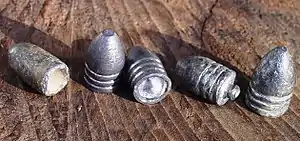Springfield Model 1863
The Springfield Model 1863 is a .58 caliber rifled musket manufactured by the Springfield Armory between 1863 and 1865.
| Model 1863 Rifle-Musket | |
|---|---|
 | |
| Type | Rifled musket |
| Place of origin | United States of America |
| Service history | |
| In service | 1863–1865 |
| Used by | |
| Wars | |
| Production history | |
| Designer | ? |
| Designed | 1863 |
| Manufacturer | United States Armory and Arsenal at Springfield |
| Produced | 1863–1865 |
| No. built | 700,000 |
| Variants | Type I, Type II |
| Specifications | |
| Mass | 9 lb (4.1 kg) |
| Length | 55.9 in (1,420 mm) |
| Barrel length | 40.0 in (1,020 mm) |
| Cartridge | Paper cartridge, Minié ball undersized to reduce the effects of powder fouling and for the skirt to get grip of the grooves when firing |
| Caliber | .58 in (15 mm) |
| Action | Percussion lock |
| Rate of fire | User dependent; usually 2 to 4 rounds every 1 minute |
| Muzzle velocity | 1,000 to 1,200 ft/s (300 to 370 m/s) |
| Effective firing range | 800 to 1000 yards, in reality 200 to 300 yards |
| Maximum firing range | ? |
| Feed system | Muzzle-loaded |
| Sights | Flip-up leaf sights/single leaf sight |



The Model 1863 was only a minor improvement over the Springfield Model 1861. As such, it is sometimes classified as just a variant of the Model 1861. The Model 1861, with all of its variants, was the most commonly used longarm in the American Civil War, with over 700,000 manufactured. The Model 1863 also has the distinction of being the last muzzle-loading longarm produced by the Springfield Armory.
The Model 1863 was produced in two variants. The Type I eliminated the band springs and replaced the flat barrel bands with oval clamping bands. It also featured a new ramrod, a case-hardened lock, a new hammer, and a redesigned bolster (percussion chamber). Several of these modifications were based upon Colt's contract model 1861, known as the "Colt special". 273,265 Type I variants were manufactured in 1863.
The Type II is sometimes referred to as the Model 1864, but is more commonly referred to as just a variant of the Model 1863. This version re-introduced band springs, replaced the clamping bands with solid oval bands, and replaced the three leaf rear sight with single leaf sight. A total of 255,040 of these were manufactured from 1864 to 1865.
By the end of the Civil War, muzzle-loading rifles and muskets were considered obsolete. In the years following the Civil War, many Model 1863 muskets were converted into breech-loading "Trapdoor Springfields". The breech-loading weapons increased the rate of fire from three to four rounds per minute to eight to ten rounds per minute. The Model 1863 could be converted to breech-loading for about five dollars, at a time when a new rifle would cost about twenty dollars. The conversion of Model 1863 rifles therefore represented a significant cost savings to the U.S. military. (The US Military never adopted the converted Springfields although many were used by various European militaries)
See also
- List of individual weapons of the U.S. Armed Forces
- List of wars involving the United States
- Military history of the United States
- United States Armed Forces
- Military of the Confederate States of America
- Charleville musket
- Brown Bess
- Potzdam Musket 1723
- M1752 Musket
- Springfield musket
- Harpers Ferry Model 1803
- M1819 Hall rifle
- Pattern 1853 Enfield
- Springfield Rifle
- Richmond rifle
- Fayetteville rifle
- Springfield Model 1865 First model "Trapdoor Springfield" based on the Model 1863
- Springfield Model 1866 Second model "Trapdoor Springfield" based on the Model 1863
- Musket
- Rifle
- Carbine
- American Civil War reenactment
External links
References
- Earl J. Coates and Dean S. Thomas, An Introduction to Civil War Small Arms
- Ian V. Hogg, Weapons of the Civil War